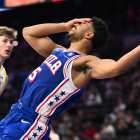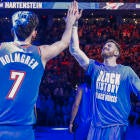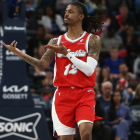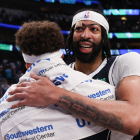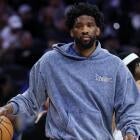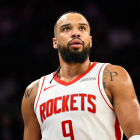The Don Quixote of basketball has given up the windmill.
Sam Hinkie resigned as general manager of the Philadelphia 76ers Wednesday, three years and 47 wins into a rebuilding effort that was at times fascinating, frustrating, mind-boggling, quixotic, bizarre and brilliant, often all at once. Hinkie reportedly wrote a 13-page resignation letter, explaining his decision to ownership as one of being unable to proceed in good conscience. Reports indicate that Hinkie was asked to take a lesser role in the organization, and that spurred his decision to step down.
In essence, it seems that Hinkie effectively decided that if the Sixers weren't going to allow him to finish what he started, for better or worse, he wasn't going to waste his time. For Hinkie, the Process was about how you go about building a team, but more than that, it was about a holistic approach. That same kind of thinking has led to greatness in San Antonio and in Golden State, who have both taken great care to instill the same kind of philosophy from their coaches to their players to their analytics staff. The idea is to do everything in concert toward making the best decision and taking the best action.
The recent moves in Philadelphia, from hiring Jerry Colangelo to adding Mike D'Antoni to the assistant coaching staff, were clear indications that ownership no longer believed in where Hinkie was leading the team. Once that trust was broken, they turned to Colangelo who now reportedly will install his son, former Toronto Raptors GM Bryan Colangelo, as the new general manager. There have been reports and rumors that the new directive is about a move toward respectability, trying to just get the team back to being somewhat of an actual NBA team.
The problem with that, of course, is that down that roads lies mediocrity, the very same thing that Hinkie was brought in to help the Sixers escape. For years after the Allen Iverson era ended, the Sixers were within range of the playoffs, or in by a hair as a 7th or 8th seed, but never a serious challenge. They were stuck in purgatory. Good enough to hang around and get a first round's worth of playoff revenue, never really relevant in a meaningful way.
Ownership wanted to really compete, to build a championship organization on par with the other great teams in the league. And Hinkie, honestly, went about that the right way. He traded their veterans for draft picks, cleared the cap space and pursued a franchise star in the draft relentlessly. Had the lottery balls fell his way in 2014, giving him Andrew Wiggins or Jabari Parker, things might have been different. Had those numbers been kinder in 2015, giving Philly Karl-Anthoy Towns, or even, yes, D'Angelo Russell, Hinkie might be in a very different situation.
They didn't.
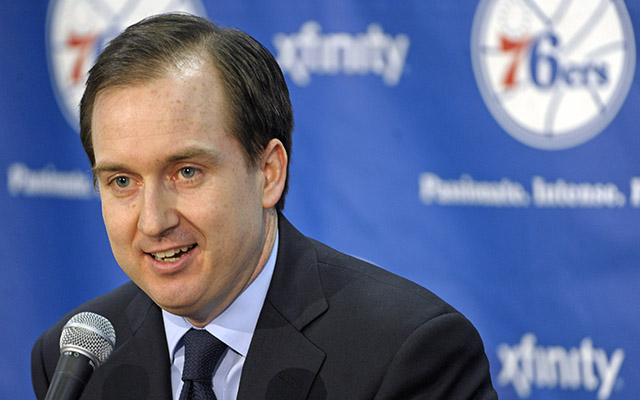
Instead, Hinkie was stuck with impossible choices. After bottoming out beyond anyone's belief in 2014, he was on the outside of the two top choices, the easy picks. It was here that really the end of the Process began. Hinkie chose to go with the player with the best chance of being an all-time great, but the lowest chance of being an actual rotation player in Joel Embiid, who was medically red-flagged with stress fractures in his foot and back. One of these would be enough to scare off swarms of teams from a big man. His having both conditions was catastrophic.
You can ask whom else Hinkie should have taken, but if he knew that the process might require another year of pain, why not take Aaron Gordon, Dante Exum or Marcus Smart, players who surely could turn out to be all-stars even now, but at the very least would help the team be better without actually affecting the win-loss record.
Instead, Hinkie not only gambled with that much of a dare with the most important pick of his tenure, but doubled down on it by taking Euro grab-and-stash Dario Saric, who still might not join the NBA next season.
Embiid's foot cost him an entire season, and then another. He has yet to play in an NBA game; Saric remains dominant in Turkey. In the most important draft of his tenure, Sam Hinkie walked away with two players in the top 10 who two years later have yet to log a single NBA minute.
The Jahlil Okafor pick a year later was a similar quandary. Taking Kristaps Porzingis that high was considered lunacy, even for as good as Porzingis' workout in L.A. had been. Had Hinkie followed through with the "highest ceiling" pick last June, ironically, he would likely still be with the Sixers. Instead, he took the safe pick, giving them three centers, none of whom look like a franchise icon.
Okafor was a good pick. He's going to be a good NBA player for years, and will have stretches where he's downright dominant offensively. He's not the first low-post scoring big man to have defensive problems, and all such players can move past them with the right scheme and personnel around them. His off-court problems scream of the stupid mistakes of a 20-year-old, not some huge problem that lies within him, at least, not yet.
Hinkie made mistakes. He never acquired a quality starting NBA point guard to just simply run the team and make the offense make sense. He constantly irked his peers with this approach, which many felt was an embarrassment to the game. Now that he's out, the vultures have come calling, saying that Hinkie had trouble with communication in the organization.
And yet, Hinkie did what his owners wanted. He did the most he could to chase the dream. He didn't take shortcuts to save his job, he didn't mitigate the team's potential so that they could wind up with 35 wins and some sort of "hey, maybe they can make the playoffs" feeling in January that quickly fades. He took an absolutist approach to a daring philosophy, and in the end, he found that there's only so much pain that a team, that a league, can stomach.
Hinkie's tenure with the Sixers is going to have legacy. There have already been suggested changes to the lottery structure because of what Hinkie tried to configure by collecting the most losses in the league. (Ironically, the Sixers did not collect the No. 1 pick in any of those three years, and in 2014, which started this whole thing, finished second in the lottery standings behind the Bucks.) Teams will likely reconsider the idea of "blowing it up" completely for fear of repeating what happened to and by the hand of the Sixers.
More worrisome, the Sixers might now be seeking a terrible new goal, simply trying to compete for the sake of competing, and hoping that magically things turn out. Maybe they will. Maybe Embiid's foot problems clear up and he becomes the Olajuwon Redux he looked so closely like in college. Maybe Saric joins and the team trades Okafor for a bevy of assets who give the Sixers a "young-Thunder-like" vibe and the team takes off.
But if that happens, it'll be built on the foundation of what Sam Hinkie built.
If they go the other direction, mortgaging assets for short-term solutions, looking to exploit cap space to find immediate roster upgrades, forgoing long-term planning for simple flash and ticket sales ... well, they should look at their Atlantic Division neighbors in Brooklyn for how that turns out.
The Sam Hinkie era is over. The Process is dead, long live the Process. You can call this story a tragedy, you can call it a joke, you can call it anything you like, but you have to admit ...
It was fascinating while it lasted.
![[object Object] Logo](https://sportshub.cbsistatic.com/i/2020/04/22/e9ceb731-8b3f-4c60-98fe-090ab66a2997/screen-shot-2020-04-22-at-11-04-56-am.png)









